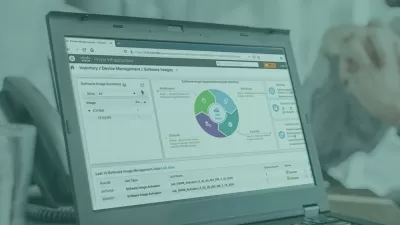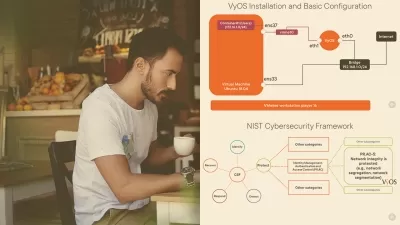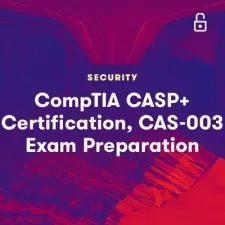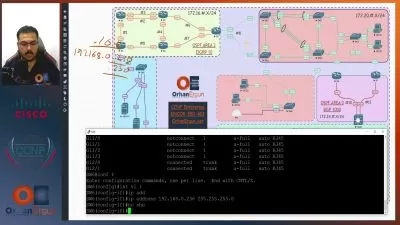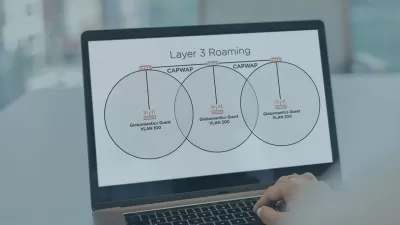Juniper JNCIS-SP Service Provider JN0-363 Full Course
Skill Nuggets
26:08:33
Description
Get your Juniper Service Provider certification with this course. you can get the Juniper JNCIS-SP JN0-363
What You'll Learn?
- An understanding of Juniper service provider technology in modern networking with both enterprise and service provider environments, JNCIS-SP JN0-363 success
- with your JNCIS-SP JN0-363 exam passed You will be confident in dealing with Juniper equipment in your dervice provider work place and stand out from the others
- you will learn everything thats required to pass the Juniper JNCIS-SP JN0-363 service provider exam
- A good foundation into the Juniper JNCIP Enterprise and JNCIP Service Provider , Bring these skills to the workplace
- You will lean MPLS, LDP, RSVP and CSPF and basic Segment routing for the Service Provider
- All topics for the Juniper JNCIS-SP JN0-363 Service Provider are covered
- Other topics for the Juniper JNCIS-ENT Enterprise Routing and Switching are covered
- How Junipe Junos configs are doen for OSPF, BGP, IS-IS and static routing. Route leaking and load balancing
- enterprise switching upskill for the JNCIS-ENT JN0-349
Who is this for?
More details
DescriptionThis Juniper JNCIS-SP Service Provider JN0-363 course is my second course on Juniper Networks.
The Juniper Service Provider JNCIS-SP JN0-363 details are below and the JNCIS-ENT JN0-349 is 90% covered with the Intermediate routing and service provider switching so some additional upskill for the Juniper JN0-349 is also included.
The Juniper Intermediate Routing Section is required and below is a summary of what we will cover:
Implement static routing within Junos OS
Implement routing instances within Junos OS
Describe routing instances
Configure and share routes between routing instances
Implement load balancing within Junos OS
Implement filter-based forwarding within Junos OS
Implement OSPF within Junos OS
Deploy OSPF within Junos OS
Implement BGP within Junos OS
Deploy BGP within Junos OS
Implement IP tunneling within Junos OS
Implement graceful routing and bidirectional forwarding detection within Junos OS
Implement high availability features—GRES, NSR, and unified ISSU within Junos OS
Implement VRRP within Junos OS
Implement IPv6 within Junos
Implement IS-IS within Junos OS
The Juniper JNCIS-SP JN0-363 Service Provider requires the Service Provider Switching module and we will go through the following:
. Describe the different Ethernet standards organizations.
• Describe the Layer 2 services that are available on the MX Series 3D Ethernet
Universal Edge Routers.
• Describe the function of an Ethernet LAN.
• Describe learning and forwarding in a bridging environment.
• Describe Ethernet frame filtering.
• Implement VLAN tagging.
• Describe and implement MVRP.
• Implement IRB.
• Implement a Layer 2 firewall filter.
• Describe the use of a routing instance.
• Describe the function of a virtual router.
• Describe the function of a virtual switch.
• Describe the usage of logical systems.
• Implement a virtual switch.
• Describe interconnecting routing instances.
• Describe the different IEEE VLAN stacking models.
• Describe the components of provider bridging.
• Configure and monitor provider bridging.
• Explain the purpose of the Spanning Tree Protocol (STP).
• Describe the basic operation of STP, Rapid Spanning Tree Protocol (RSTP),
Multiple Spanning Tree Protocol (MSTP), and VLAN Spanning Tree Protocol
(VSTP).
• Configure and monitor STP, RSTP, MSTP, and VSTP.
• Explain the purpose of bridge protocol data unit (BPDU), loop, and root
protection.
• Describe the basic operation of LAGs and MC-LAGs.
• Configure and monitor LAGs and MC-LAGs.
• Describe the basic functionality of MX Series Virtual Chassis.
• Describe a basic troubleshooting method.
• List common issues that disrupt network operations.
• Identify tools used in network troubleshooting.
• Use available tools to resolve network issues
And last for the Juniper JNCIS-SP JN0-363 Service Provided the MPLS module and we will go through the below content.
• Explain the reasons MPLS was originally created, and the applications offered
by label-switched paths.
• Describe the structure of an MPLS label, the mechanics of the data plane, and
the protocols that can advertise labels.
• Configure static LSPs, verify the routing tables they populate, and explain the
label actions these LSPs perform.
• Explain the purpose and advantages of RSVP, then configure a service provider
network to host RSVP LSPs.
• Configure and verify a basic RSVP label-switched path.
• Explain the purpose of the MPLS traffic engineering database, and create LSPs
that use this database to calculate a path.
• Explain the purpose of RSVP bandwidth reservations, and how to configure an
LSP to reserve bandwidth.
• Explain the use-cases for RSVP LSP priority levels, and configure different
priority levels of a variety of LSPs.
• Explain how the Constrained Shortest-Path First algorithm can calculate trafficengineered paths.
• Explain the messages involved in tearing down, rerouting, and maintaining LSPs
and RSVP sessions.
• Describe how primary and secondary paths can be used in times of link and
node failure.
• Describe the advantages of RSVP local repair paths, and how to configure the
one-to-one method of local repair, otherwise known as fast reroute.
• Explain the mechanics, configuration, and verification of facility backup,
otherwise known as link protection and node-link protection.
• Explain how RSVP LSPs can automatically find and signal better, more optimal
paths.
• Explain how LSPs can gracefully move traffic to new paths with no downtime
to the user.
• Explain the mechanics by which LDP creates a full mesh of label-switched
paths.
• Configure and verify a basic LDP deployment in a service provider network.
• Describe some important LDP enhancements and best practices that increase
the integrity of real-world LDP deployments.
• Explain how to configure LDP to advertise labels for more than just a router's
loopback.
• Explain how segment routing differs from RSVP and LDP, and configure
segment routing as a replacement for LDP.
Extra content to assist in upskilling for the Juniper JNCIS-ENT JN0-349
Who this course is for:
- Network Engineers of all levels that want to learn Juniper Junos JNCIS-SP JN0-363 or looking for layer2 content for the Juniper JN0-349. this course is the foundation for your further studies
- Engineers that want to further their study into the Juniper JNCIP -SP or JNCIP -ENT as this course will provide the base information
- Students looking to study for the Juniper JNCIS-ENT JN0-349 or Juniper JNCIS-SP JN0363 exam
This Juniper JNCIS-SP Service Provider JN0-363 course is my second course on Juniper Networks.
The Juniper Service Provider JNCIS-SP JN0-363 details are below and the JNCIS-ENT JN0-349 is 90% covered with the Intermediate routing and service provider switching so some additional upskill for the Juniper JN0-349 is also included.
The Juniper Intermediate Routing Section is required and below is a summary of what we will cover:
Implement static routing within Junos OS
Implement routing instances within Junos OS
Describe routing instances
Configure and share routes between routing instances
Implement load balancing within Junos OS
Implement filter-based forwarding within Junos OS
Implement OSPF within Junos OS
Deploy OSPF within Junos OS
Implement BGP within Junos OS
Deploy BGP within Junos OS
Implement IP tunneling within Junos OS
Implement graceful routing and bidirectional forwarding detection within Junos OS
Implement high availability features—GRES, NSR, and unified ISSU within Junos OS
Implement VRRP within Junos OS
Implement IPv6 within Junos
Implement IS-IS within Junos OS
The Juniper JNCIS-SP JN0-363 Service Provider requires the Service Provider Switching module and we will go through the following:
. Describe the different Ethernet standards organizations.
• Describe the Layer 2 services that are available on the MX Series 3D Ethernet
Universal Edge Routers.
• Describe the function of an Ethernet LAN.
• Describe learning and forwarding in a bridging environment.
• Describe Ethernet frame filtering.
• Implement VLAN tagging.
• Describe and implement MVRP.
• Implement IRB.
• Implement a Layer 2 firewall filter.
• Describe the use of a routing instance.
• Describe the function of a virtual router.
• Describe the function of a virtual switch.
• Describe the usage of logical systems.
• Implement a virtual switch.
• Describe interconnecting routing instances.
• Describe the different IEEE VLAN stacking models.
• Describe the components of provider bridging.
• Configure and monitor provider bridging.
• Explain the purpose of the Spanning Tree Protocol (STP).
• Describe the basic operation of STP, Rapid Spanning Tree Protocol (RSTP),
Multiple Spanning Tree Protocol (MSTP), and VLAN Spanning Tree Protocol
(VSTP).
• Configure and monitor STP, RSTP, MSTP, and VSTP.
• Explain the purpose of bridge protocol data unit (BPDU), loop, and root
protection.
• Describe the basic operation of LAGs and MC-LAGs.
• Configure and monitor LAGs and MC-LAGs.
• Describe the basic functionality of MX Series Virtual Chassis.
• Describe a basic troubleshooting method.
• List common issues that disrupt network operations.
• Identify tools used in network troubleshooting.
• Use available tools to resolve network issues
And last for the Juniper JNCIS-SP JN0-363 Service Provided the MPLS module and we will go through the below content.
• Explain the reasons MPLS was originally created, and the applications offered
by label-switched paths.
• Describe the structure of an MPLS label, the mechanics of the data plane, and
the protocols that can advertise labels.
• Configure static LSPs, verify the routing tables they populate, and explain the
label actions these LSPs perform.
• Explain the purpose and advantages of RSVP, then configure a service provider
network to host RSVP LSPs.
• Configure and verify a basic RSVP label-switched path.
• Explain the purpose of the MPLS traffic engineering database, and create LSPs
that use this database to calculate a path.
• Explain the purpose of RSVP bandwidth reservations, and how to configure an
LSP to reserve bandwidth.
• Explain the use-cases for RSVP LSP priority levels, and configure different
priority levels of a variety of LSPs.
• Explain how the Constrained Shortest-Path First algorithm can calculate trafficengineered paths.
• Explain the messages involved in tearing down, rerouting, and maintaining LSPs
and RSVP sessions.
• Describe how primary and secondary paths can be used in times of link and
node failure.
• Describe the advantages of RSVP local repair paths, and how to configure the
one-to-one method of local repair, otherwise known as fast reroute.
• Explain the mechanics, configuration, and verification of facility backup,
otherwise known as link protection and node-link protection.
• Explain how RSVP LSPs can automatically find and signal better, more optimal
paths.
• Explain how LSPs can gracefully move traffic to new paths with no downtime
to the user.
• Explain the mechanics by which LDP creates a full mesh of label-switched
paths.
• Configure and verify a basic LDP deployment in a service provider network.
• Describe some important LDP enhancements and best practices that increase
the integrity of real-world LDP deployments.
• Explain how to configure LDP to advertise labels for more than just a router's
loopback.
• Explain how segment routing differs from RSVP and LDP, and configure
segment routing as a replacement for LDP.
Extra content to assist in upskilling for the Juniper JNCIS-ENT JN0-349
Who this course is for:
- Network Engineers of all levels that want to learn Juniper Junos JNCIS-SP JN0-363 or looking for layer2 content for the Juniper JN0-349. this course is the foundation for your further studies
- Engineers that want to further their study into the Juniper JNCIP -SP or JNCIP -ENT as this course will provide the base information
- Students looking to study for the Juniper JNCIS-ENT JN0-349 or Juniper JNCIS-SP JN0363 exam
User Reviews
Rating
Skill Nuggets
Instructor's Courses
Udemy
View courses Udemy- language english
- Training sessions 127
- duration 26:08:33
- Release Date 2023/05/14






